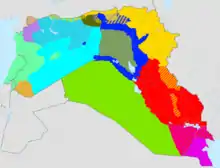Baghdadi Arabic
Baghdadi Arabic is the Arabic dialect spoken in Baghdad, the capital of Iraq. During the last century, Baghdadi Arabic has become the lingua franca of Iraq, and the language of commerce and education. It is considered a subset of Iraqi Arabic.[2]
| Baghdadi Arabic | |
|---|---|
| Muslim Baghdadi Arabic, Iraqi Arabic | |
| اللهجة البغدادية | |
| Native to | Iraq, eastern Syria, Kuwait, parts of eastern Arabia, Khuzestan Province in Iran |
| Region | Baghdad, Basra |
Native speakers | About 15.7 million speakers (2014-2016)[1] |
Afro-Asiatic
| |
| Dialects | |
| Arabic alphabet | |
| Language codes | |
| ISO 639-3 | acm – Mesopotamian Arabic |
| Glottolog | meso1252 |
 red - Baghdadi Arabic | |
An interesting sociolinguistic feature of Baghdadi Arabic is the existence of three distinct dialects: Muslim, Jewish and Christian Baghdadi Arabic. Muslim Baghdadi belongs to a group called gilit dialects, while Jewish Baghdadi (as well as Christian Baghdadi) belongs to qeltu dialects. The latter two thus are more related to North Mesopotamian-Anatolian Arabic than Iraqi Arabic.
During the first decades of the 20th century, when the population of Baghdad was less than a million, some inner city quarters had their own distinctive speech characteristics, maintained for generations. From about the 1960s, with the population movement within the city, and the influx of large numbers of people hailing mainly from the south, Baghdad Arabic has become more standardized, and has come to incorporate some rural features and Modern Standard Arabic loanwords.
Distinct features of Muslim Baghdadi Arabic include the use of 'ani' as opposed to the fusha 'ana' meaning 'I am' and the addition of the suffix 'ich' to verbs with female direct objects, e.g. 'ani gilitlich' meaning 'I told you' whereas North Mesopotamian-Anatolian Arabic speakers would say: 'ana qeltolki'.
Phonology
Vowels
The vowel phoneme /eː/ (from standard Arabic /aj/) is usually realised as an opening diphthong, for most speakers only slightly diphthongised [ɪe̯], but for others a more noticeable [iɛ̯], such that, for instance, lēš [why] will sound like leeyesh. There's a vowel phoneme that evolved from the diphthong (/aw/) to resemble more of a long (/o:/) sound, as in words such as kaun [universe] shifting to kōn.
| Short | Long | |||
|---|---|---|---|---|
| Front | Back | Front | Back | |
| Close | /ɪ/ | /u/ | /iː/ | /uː/ |
| Mid | /eː/ | /oː/ | ||
| Open | /æ/ | /aː/ | ||
Consonants
Even in the most formal of conventions, pronunciation depends upon a speaker's background.[3] Nevertheless, the number and phonetic character of most of the 28 consonants has a broad degree of regularity among Arabic-speaking regions. Note that Arabic is particularly rich in uvular, pharyngeal, and pharyngealized ("emphatic") sounds. The emphatic coronals (/sˤ/, /tˤ/, and /ðˤ/) cause assimilation of emphasis to adjacent non-emphatic coronal consonants. The phonemes /p/ ⟨پ⟩ and /v/ ⟨ڤ⟩ (not used by all speakers) are not considered to be part of the phonemic inventory, as they exist only in foreign words and they can be pronounced as /b/ ⟨ب⟩ and /f/ ⟨ف⟩ respectively depending on the speaker.[4][5]
| Labial | Dental | Coronal | Palatal | Velar | Uvular | Pharyngeal | Glottal | |||
|---|---|---|---|---|---|---|---|---|---|---|
| plain | emphatic | |||||||||
| Nasal | m | n | ||||||||
| Stop/Affricate | voiceless | (p) | t | tˤ | t͡ʃ | k | ʔ | |||
| voiced | b | d | ʤ | g | ||||||
| Fricative | voiceless | f | θ | s ~ ɕ | sˤ | ʃ | x ~ χ | ħ ~ ʜ | h | |
| voiced | (v) | ð | z ~ ʑ | ðˤ | ɣ ~ ʁ | ʕ ~ ʢ | ||||
| Tap | r | |||||||||
| Approximant | l | ɫ | j | w | ||||||
Phonetic notes:
References
- Kees Versteegh, et al. Encyclopedia of Arabic Language and Linguistics, BRILL, 2006.
- Abū-Haidar, Farīda (1991). Christian Arabic of Baghdad. Otto Harrassowitz Verlag. ISBN 9783447032094.
- Specific
- "Arabic, Mesopotamian Spoken - Ethnologue". Ethnologue. Simons, Gary F. and Charles D. Fennig (eds.). 2017. Ethnologue: Languages of the World, Twentieth edition. Retrieved 21 March 2017.
- Hann, Geoff, 1937- author. (7 August 2015). Iraq : the ancient sites & Iraqi Kurdistan : the Bradt travel guide. ISBN 9781841624884. OCLC 880400955.CS1 maint: multiple names: authors list (link)
- Holes (2004:58)
- Teach Yourself Arabic, by Jack Smart (Author), Frances Altorfer (Author)
- Hans Wehr, Dictionary of Modern Written Arabic (transl. of Arabisches Wörterbuch für die Schriftsprache der Gegenwart, 1952)